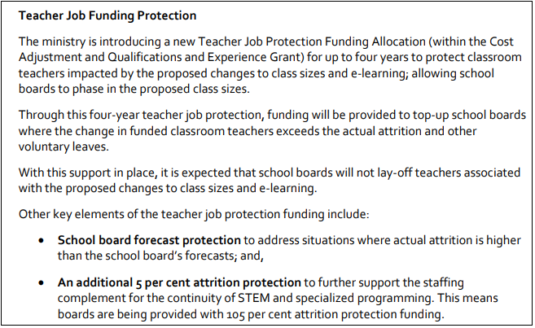Politics, class size, and political “announcements” – is there any real change?
Has the province changed its mind on funding for high school teachers and class size? That’s the question many are asking this week.
The answer appears to be no.
A memo to school boards sent August 22nd makes no change to funding for education. And at a press conference in Scarborough, Minister of Education Stephen Lecce confirmed that, “The plan unveiled in the spring is being realized.” The plan announced in the spring and the technical paper that outlines funding for school boards includes funding changes that will gradually reduce the number of teachers in Ontario secondary schools.

From the 2019/20 Ontario Education Funding Technical Paper
It continues to be the case that – because of funding reductions – teachers who are retiring or resigning cannot be replaced. But boards will receive top-up funding (called the Teacher Job Funding Protection Allocation, see box) so that no teacher loses their job as a result of changes to class size funding.
What was new in the announcement?
The Minister’s announcement last week was based on updated numbers received over the summer from school boards. It appears that the combination of teacher retirements/resignations and top-up funding will result in province-wide average class sizes of approximately 22.5 students.
But at the press conference, the Minister was also clear that, in his words, “the existing plan stays.” That existing plan is to reduce funding for secondary teachers until boards receive funding at a rate of one teacher for every 28 students. However, at the press conference, the Minster said, “We’re open to ideas to bring that number down.” He said he was willing to listen to any ideas as long as they fit within the government’s “fiscal realities.”
What will change this year?
School boards across the province have already had to reduce the number of teaching positions in high schools. The result has been a reduction in course choices for high school students. Because there is no new funding, nothing in the Minister’s speech will change the reality that there are fewer secondary school teachers this year, and that boards have a great deal of the flexibility they had to run some very small specialized classes. So it is unlikely that courses that have been cut will be re-instated.
Contract negotiations with education unions create a wild card in the mix this year. Education contracts expire August 31st, and it is possible that the government may negotiate increased funding for teacher or other staff positions. That in turn may result in changes by as early as February 2020, but it is impossible to predict.
In the meantime there will be lots of “messaging” and trial balloons on all sides. It’s important to dig under the noise and find the evidence.
Listen to Annie Kidder’s interview on Metro Morning
